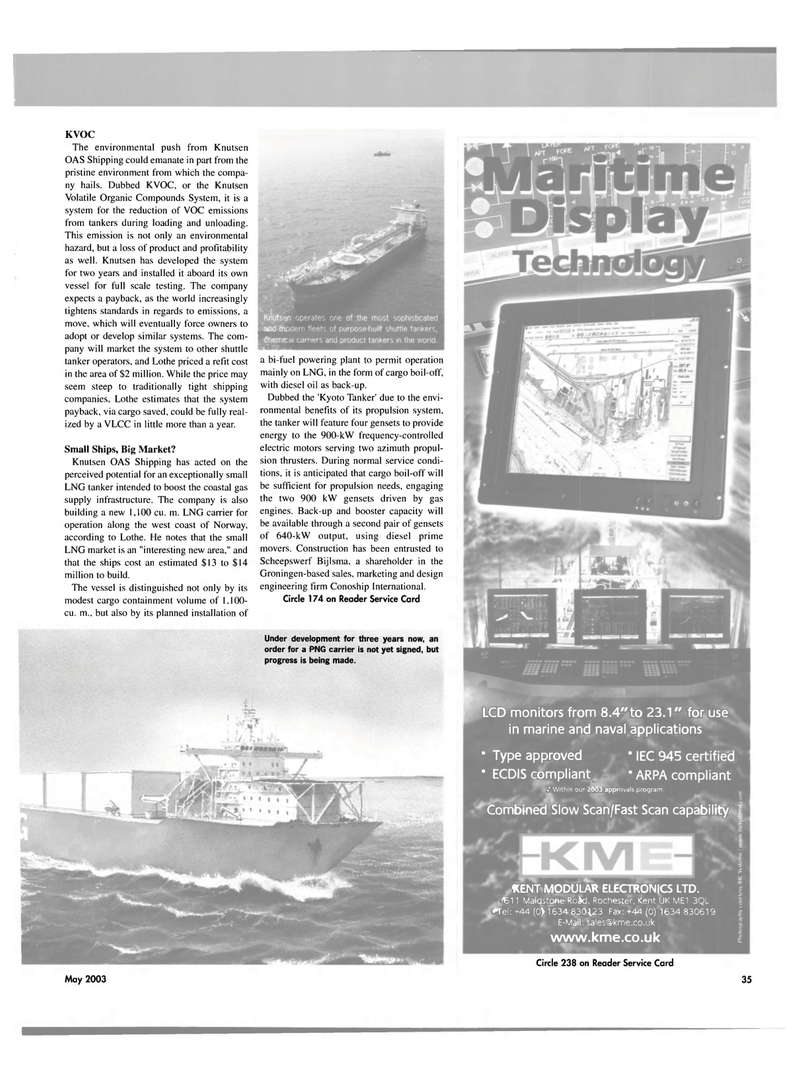
Page 35: of Maritime Reporter Magazine (May 2003)
Read this page in Pdf, Flash or Html5 edition of May 2003 Maritime Reporter Magazine
LCD monitors from 8.4"to 23.1" for use in marine and naval applications * Type approved * IEC 945 certified * ECDIS compliantp * ARPA compliant erf Within our 2003 approvals program.
Combined Slow Scan/Fast Scan capability
KENT MODULAR ELECTRONICS LTD. •<611 Maidstone Roid, Rochester, Kent UK ME1 3QL •Tel: +44 (0) 1634.830*23 Fax: +44 (0) 1634 830619 • t E-Mail: [email protected] www.kme.co.uk
Circle 238 on Reader Service Card
KVOC
The environmental push from Knutsen
OAS Shipping could emanate in part from the pristine environment from which the compa- ny hails. Dubbed KVOC, or the Knutsen
Volatile Organic Compounds System, it is a system for the reduction of VOC emissions from tankers during loading and unloading.
This emission is not only an environmental hazard, but a loss of product and profitability as well. Knutsen has developed the system for two years and installed it aboard its own vessel for full scale testing. The company expects a payback, as the world increasingly tightens standards in regards to emissions, a move, which will eventually force owners to adopt or develop similar systems. The com- pany will market the system to other shuttle tanker operators, and Lothe priced a refit cost in the area of $2 million. While the price may seem steep to traditionally tight shipping companies, Lothe estimates that the system payback, via cargo saved, could be fully real- ized by a VLCC in little more than a year.
Small Ships, Big Market?
Knutsen OAS Shipping has acted on the perceived potential for an exceptionally small
LNG tanker intended to boost the coastal gas supply infrastructure. The company is also building a new 1,100 cu. m. LNG carrier for operation along the west coast of Norway, according to Lothe. He notes that the small
LNG market is an "interesting new area," and that the ships cost an estimated $13 to $14 million to build.
The vessel is distinguished not only by its modest cargo containment volume of 1,100- cu. m., but also by its planned installation of a bi-fuel powering plant to permit operation mainly on LNG, in the form of cargo boil-off, with diesel oil as back-up.
Dubbed the 'Kyoto Tanker' due to the envi- ronmental benefits of its propulsion system, the tanker will feature four gensets to provide energy to the 900-kW frequency-controlled electric motors serving two azimuth propul- sion thrusters. During normal service condi- tions, it is anticipated that cargo boil-off will be sufficient for propulsion needs, engaging the two 900 kW gensets driven by gas engines. Back-up and booster capacity will be available through a second pair of gensets of 640-kW output, using diesel prime movers. Construction has been entrusted to
Scheepswerf Bijlsma, a shareholder in the
Groningen-based sales, marketing and design engineering firm Conoship International.
Circle 174 on Reader Service Card
Under development for three years now, an order for a PNG carrier is not yet signed, but progress is being made.
May 2003 35

 34
34

 36
36
